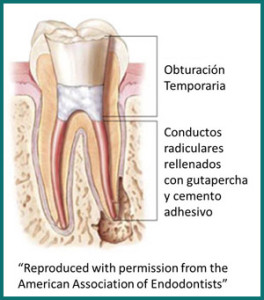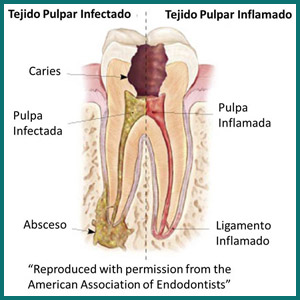Endodontics is an area of odontology that encompasses the prevention, diagnosis, and treatments of the pathologies of the dental pulp and periradicular tissues.
The dental pulp is the tissue located in the interior of the tooth cavity and it is composed of the pulp chamber and the root canal.
The endodontic treatment is commonly known as “root canal treatment”.
Causes
Dental caries are the most common cause of pulpal inflammation. Among other causes and factors that can lead to the need of an endodontic treatment we can cite dental trauma, pulpal inflammation caused by periodontal infection, prosthetic needs, abrasions, amongst others.
Most typical symptoms
Spontaneous pain, in a pulsation manner, which increases with cold or heat. In this case, the pulp is still with vitality, but inflamed, and the use of painkillers does not result in the remission of symptoms. When the pulp loses its vitality it can produce accumulation of pus in the bone that surrounds the root (abscess), generally the pain is well located and increases when chewing. Other symptoms can accompany every particular case.
Treatment
When the tooth pulp is irreversibly inflamed, necrotic, or infected, it’s necessary to carry out the endodontic treatment. The endodontic treatment consists of the removal of the sick tooth pulp, modeling of the conducts, and filling of the space previously occupied by the pulp.
After the endodontic treatment is concluded, the tooth will need a restoration or prosthetics to go back to its normal shape and functions. The radiographic control is very important, which must be carried out six months after the endodontic treatment is concluded, in order to evaluate the result of the procedure.
Advantages
Saving a dental piece through endodontic treatment has a lot of advantages:
- Efficient chewing
- Normal strength in chewing and sensitivity
- Natural look
- Protects other teeth of excessive forces.
Common questions
- Is it a painful treatment?
With the use of local anesthesia the treatment is completely painless
- Does the tooth always darken after the endodontic treatment?
The accentuated darkening is more frequent when a hemorrhage or pulpal mortification was produced before the treatment. However, even in these cases it can go back to the original color with aesthetic dentistry procedures.
- What can happen if the endodontic treatment is not carried out?
A periapical lesion can develop, which is an infection of the bone that surrounds and holds the root and neighboring tissues, and it can have more serious consequences, like intense pain, swelling, fever, and bacteremia (bacteria in blood circulation). The solution to these cases can consist of the extraction of the tooth.
Dr. Carlos Heilborn
Reg. Prof. Nº 1570
Endodontics Specialist
Descargar
Seguridad del Tratamiento de Conductos. Puntos de discusión.
Información para compartir con pacientes en relación a la seguridad de un Tratamiento de Conducto

